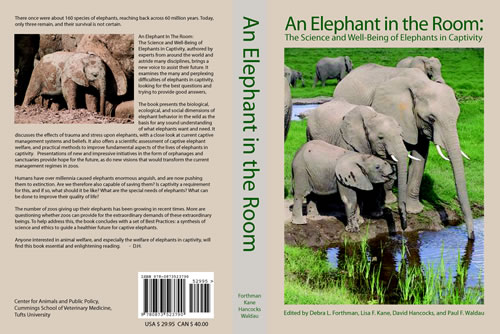A new book is on the market: An Elephant In The Room: The Science and Well-Being of Elephants in Captivity. You can buy the book from Amazon.com here.
The opening chapter in the book, Mind and Movement: Meeting the interests of elephants, is written by ElephantVoices' Joyce Poole and Petter Granli. You can download the chapter from our Document Download Center: ![]() Poole, J & Granli, P. 2008. Mind and Movement: Meeting the Interests of Elephants. (2.19 MB)
Poole, J & Granli, P. 2008. Mind and Movement: Meeting the Interests of Elephants. (2.19 MB)

Cover photos by ElephantVoices' Petter Granli.
From the back cover:
"There once were about 160 species of elephants, reaching back across 60 million years. Today, only three remain, and their survival is not certain. An Elephant In The Room: The Science and Well-Being of Elephants in Captivity, authored by experts from around the world and astride many disciplines, brings a new voice to assist their future. It examines the many and perplexing difficulties of elephants in captivity, looking for the best questions and trying to provide good answers.
The book presents the biological, ecological, and social dimensions of elephant behavior in the wild as the basis for any sound understanding of what elephants want and need. It discusses the effects of trauma and stress upon elephants, with a close look at current captive management systems and beliefs. It also offers a scientific assessment of captive elephant welfare, and practical methods to improve fundamental aspects of the lives of elephants in captivity. Presentations of new and impressive initiatives in the form of orphanages and sanctuaries provide hope for the future, as do new visions that would transform the current management regimes in zoos.
Humans have over millennia caused elephants enormous anguish, and even their imminent demise. Are we also capable of saving them? Is captivity a requirement for this, and if so, what should it be like? What are the special needs of elephants? What can be done to improve their quality of life? The number of zoos giving up their elephants has been growing in recent times. More are questioning whether zoos can provide for the extraordinary demands of these extraordinary beings.
To help address this, the book concludes with a set of Best Practices: a synthesis of science and ethics to guide a healthier future for captive elephants. Anyone interested in animal welfare, and especially the welfare of elephants in captivity, will find this book essential and enlightening reading."
An Elephant in the Room: The Science and Well-being of Elephants in Captivity is available on Amazon.com.

